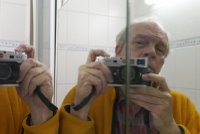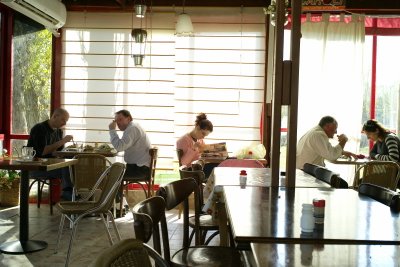|
simple is beautiful


The Online Photographer
 2 ... 2 ... 2 ... 2 ... |
Friday, 16 February 2007Thursday, 15 February 2007Digitally Imaging the Unicorn Scott Kirkpatrick makes reference in his Leica M8 post to the Leica S1 and the unicorn tapestries. Here's where you can find the utterly charming story of the Chudnovsky Mathematician (two brothers who insist they are one mathematician occupying two distinct bodies), the computer called It built in part with supplies from Home Depot, and the digital imaging of the tapestries. It's a long article, so perhaps you'll have to wait until you have time, but it's fascinating—not to be missed. Scott Kirkpatrick makes reference in his Leica M8 post to the Leica S1 and the unicorn tapestries. Here's where you can find the utterly charming story of the Chudnovsky Mathematician (two brothers who insist they are one mathematician occupying two distinct bodies), the computer called It built in part with supplies from Home Depot, and the digital imaging of the tapestries. It's a long article, so perhaps you'll have to wait until you have time, but it's fascinating—not to be missed.Posted by: MIKE JOHNSTON, thanks to Nick ADDENDUM by Eolake: Ten minutes of video about the unicorn project from NOVA Science Now Wednesday, 14 February 2007A Further Note...
...About the Lightroom books below: Just to be clear, these are titles that are available for pre-order. As far as I know none of them are shipping yet. I assume that most if not all of them will ship on Feb. 20th when Lightroom ships, but I don't know that. Although it's possible that review copies are in the hands of some reviewers already, I haven't seen, read, or reviewed any of these books. The listing below is only a listing of what's available for purchase now, provided for your convenience. I cannot, and therefore do not, explicitly endorse or recommend any of them.
I might also caution potential purchasers to remember that in all likelihood, you're only going to need one of them! Posted by: MIKE JOHNSTON Lightroom and Lightroom Books
Speaking of books, you can currently pre-order any of a number of soon-to-be-released Lightroom books, as well as the Lightroom program itself prior to the official February 20th release.
As you know if you haven't been hiding from the law or on sabbatical on Tahiti, Lightroom is the new photography-only "light-table" photo-organizing and -editing program from the makers of Photoshop that incorporates many features from Bridge and Camera Raw in a slick new interface. Release 1.0 is bound to be pretty well-honed, as it's been out in free beta for a year now. Given its price relative to Photoshop, Lightroom is sure to become the new standard for everyone but prepress and retouching specialists and photo-illustrators. CLICK HERE CLICK HERE CLICK HERE All the links that follow are for the U.S.:  Pre-order Adobe Lightroom Pre-order Adobe Lightroom The Adobe Photoshop Lightroom Book: The Complete Guide for Photographers The Adobe Photoshop Lightroom Book: The Complete Guide for PhotographersPublisher: Adobe Press Page count: 352 Price: $26.40 Availability: pre-order  Adobe Photoshop Lightroom Book for Digital Photographers Adobe Photoshop Lightroom Book for Digital PhotographersPublisher: New Riders Press Page count: 200 Price: $26.39 Availability: pre-order  Adobe Photoshop Lightroom Killer Tips Adobe Photoshop Lightroom Killer TipsPublisher: New Riders Press Page count: 240 Price: $23.09 Availability: pre-order only  Adobe Photoshop Lightroom for Digital Photographers Only Adobe Photoshop Lightroom for Digital Photographers OnlyPublisher: Wiley Page count: 352 Price: $23.09 Availability: pre-order  Lightroom Workflow: The Digital Photographer's Guide Lightroom Workflow: The Digital Photographer's GuidePublisher: Sybex Page count: 336 Price: $26.39 Availability: pre-order  Digital Photographer's Guide to Adobe Photoshop Lightroom Digital Photographer's Guide to Adobe Photoshop Lightroomby John Beardsworth Publisher: Lark Books Page count: 144 Price: $19.77 Availability: pre-order (No cover image available) Photoshop Lightroom Adventure: Mastering Adobe's Next-Generation Tool for Digital Photographers Publisher: O'Reilly Media Page count: 344 Price: $26.39 Availability: pre-order Posted by: MIKE JOHNSTON with thanks to Yvonne Cunnington and Robert-Paul Sagner Random ExcellenceIn Evren Sahin's India gallery, notice how he often partitions the frames, dividing the visual space up into completely separate stages, and how skillfully he places central subjects at the edges of pictures—sometimes, as here, mirroring the edges. He has a great knack of shaping radically cropped elements. I can't remember the last time I've seen new work that uses the frame so energetically. Posted by: MIKE JOHNSTON The Leica M8 Introductionby Scott Kirkpatrick I had two reactions to Mike's somewhat patronizing faint praise for the Leica M8 and his description of its rollout in the DMR post a few days ago. First, the comparison with Harley-Davidson leaves out a lot that is interesting about the Leica M transition to digital. When Leica went digital it took three steps. There was an S1 technical camera (think of a Horseman with a scanning three-row CCD back) which no one remembers except the folks at New York's Metropolitan Museum, who imaged the back side of the restored Unicorn tapestries, thread by thread, by recording it on an S1 and then creating the world's biggest mosaic. Then the DMR. Finally, they were ready to take the plunge to see if a new revenue stream could begin with the M8. A digital camera is a computer in back of a lens, encased in a camera body. Leica understands lenses and bodies. Leica marketing must know that all those great lenses are out there, waiting for new cameras to shoot on. But to design the electronics and write the firmware for the stuff inside the camera requires a class of geeks that I imagine both the marketing and optical/mechanical engineering people at Leica dreaded having to deal with. Financial realities would most likely have required that Leica only hire a coordinating layer of people to write specifications and interface with contractors (at Sinar for the DMR and at Jenoptik and Phase One for the M) who really do the work. I imagine the low credibility usually granted to this kind of engineering interface work would not have helped to increase communication among the team of many new people that put the M8 together in less than two years, a short time for a product this complex. Most of the teething troubles of the M8—streaks, freezeups, battery management uncertainties— have happened to all new models of digital appliances, and get solved in time without too much fuss. Two others are clear reflections of this culture shock. Even before the camera was fully released and posting raw files was permitted, those who could read the bootleg files available, or the spec which said that every raw DNG file would be exactly 10MB long, realized that something was wrong with the public statement that the M8 would offer "full 16-bit" resolution. It didn't take long to figure out that Kodak's 14-bit data was being transformed by a sort of simple gamma transform into 8 bits per pixel. This was confirmed eventually by an article in Leica Fotographie International, so Leica knew this, but the marketing statements were never corrected, even to say "16-bit range" instead of "16-bit resolution." My speculation is that someone in the "untouchable" firmware layer at Leica had tried for a while to explain this to the marketers, but couldn't get them to take the time to really understand the difference, when they were all so busy ensuring that Magnum photographers, fond reviewers, and music celebrities all had their beta M8s in time to make the right impression at Photokina. The trick turns out to be a good one. The M8 DNG files are extremely robust under post-processing, and the extra factor of 2 or more in processing speed, plus reduction of 2x in storage volume, is worthwhile. The other, much more serious, "failure to communicate" was the lack of recognition on Leica's part that ignoring an extremely high IR sensitivity would cause problems for any customer working in color, and some in B&W as well. This issue was understood by the scanning digital back community (but none of those are left at Leica after the S-1's failure). Those have no IR filtration at the sensor. Excess IR sensitivity bit Kodak and Nikon fairly badly with several early DSLR models in the late 90s and early 2000s. But Leica, until after the camera had shipped, continued to believe that this problem affected only fashion shooters who might encounter synthetic fabrics. This problem, more than any other, incited hoots and howls of derision, instant web histories, and even coherent explanations of the effect, its causes, and the different directions for resolution. Leica, to its credit, admitted the problem within two weeks, and formally announced a solution in six weeks. They leaked it even sooner—"forget about a new sensor IR filter design as that would sink the product; it's filters, guys, but we will give you some and prepare a channel if you want more of them." Beta testers and web solutions The second place where Mike presents a common and off-base misimpression is his characterization of the webforum discussions of the Leica M8's issues as the work of anal ruler-shooters, who should better spend their time taking "real pictures." Yeah, it got pretty noisy, but with its first 1500 shipped units Leica obtained beta test feedback on the M8 that they didn't have time or manpower to do themselves. It was done fast (hardware problems nailed in two weeks, some surprising consequences of offset microlenses in one month), and Leica has been able to respond. Trying to get simple, clear answers to complex questions from discussions on the web is possible only if you can learn to extract signal from a fair amount of noise. I've subscribed to the Leica-Camera-Users forum, which has hosted many critical but constructive threads, and which gives full credit to four or five main individuals (plus many others) for providing solutions that early users of the M8 could use and collecting/filtering bug reports. It has taken, typically, one or two weeks at most to get a clear sense of what are real problems and how they can be reliably made to occur. This is misunderstood by some, but once a problem is reproducible, an engineer can do something about it. The best of the forum discussions have uncovered two layers of problems so far, one already solved, a second claimed to be soluble in a coming firmware release. I hope that will be all the major issues, but who knows? The real payoff is that the M8 takes fantastic pictures. In the right hands, with its 10MP Kodak sensor, 12–14 bit dynamic range, and no AA filter, its only competition is the Canon 5D, which with good lenses doesn't cost all that much less than the M8. That's my experience with my M8 after a month of shooting, and certainly the reason that it is selling well—order backlogs continue for both cameras and lenses.  Scott Kirpatrick spent almost 20 years of his life involved with product developers in various parts of IBM. That's the source of his speculations of the cultural issues involved in trying to engineer a complex product with mechanical, optical, and digital issues and market it effectively. He wrote up a "technical business case" on the M8 introduction, which you can see on his academic web page in PowerPoint or in .pdf. Scott Kirpatrick spent almost 20 years of his life involved with product developers in various parts of IBM. That's the source of his speculations of the cultural issues involved in trying to engineer a complex product with mechanical, optical, and digital issues and market it effectively. He wrote up a "technical business case" on the M8 introduction, which you can see on his academic web page in PowerPoint or in .pdf. Posted by: SCOTT KIRKPATRICK Tuesday, 13 February 2007The Second-Worst Photographic Mistake I Ever Made Max Delbruck. A perfectly serviceable news photo, but nothing to build a career on. Not like the one that got away. Max Delbruck. A perfectly serviceable news photo, but nothing to build a career on. Not like the one that got away.By Ctein When I was an undergraduate at Caltech, late '60s, Max Delbruck won the Nobel prize. By tradition, the student newspaper turns out a same-day special edition when the school racks up another Nobel. So at the ungodly hour of 9 a.m., I'm front row center, photographing Delbruck's press conference. I make 35 nice, clear photographs (Panatomic-X plus one of those old potato masher flashes with enough watt-seconds to light the moon, and lethal voltage levels). Then I sit back: "be-prepared" photography says don't use that last frame of film. It's for that once-in-a-lifetime photo. Christ might decide to make a Second Coming at the press conference, and wouldn't you hate to be out of film? This time it paid off, big-time. The conference ended, the other reporters filed out. I was a couple of meters from Delbruck. Dick Feynman (the previous Nobel Prize winner at Caltech) strides up wearing a big grin and reaches out to embrace Delbruck. Delbruck reciprocates. With no other photographers around, I'm perfectly positioned, perpendicular to them, close enough to get a great full-frame photograph, and my flash is charged. I estimate the rate of approach and the shutter lag perfectly when I press the button. When the strobe fires (always keep both eyes open so that you can see what's photographed) they haven't quite embraced; there's a gap of six inches or so. Their heads are almost nose-to-nose but don't overlap, so you can see both of their happy, smiling profiles clearly, with their arms closing around each other. It's a classic decisive-moment photo. Exposure, focus, composition, it's all there—the kind of photograph that starts a career. Not only can I syndicate this for some decent bucks, it goes at the front of my portfolio when I go for a job with one of the big weekly magazines. No one photo's a ticket into a career, but this is as good as it gets. I'm so excited that I decide I need backup insurance. As they pull apart I rapidly wind the film to make another photograph, and ... RIII-I-I-IP!!! You just know exactly where the film ripped, don't you? Oh God, just what part of "one spare frame" didn't I understand?! If this had happened 15 years later, I'd have developed the torn-off piece of film and paid mucho dinero to get torn-in-two Frame 36 scanned and digitally reassembled. But in the late 1960s, this wasn't even a glimmer in anyone's eye. The moral? Even for a hot-shot physics major, 1 + 1 it is still going to be greater than 1. Posted by: CTEIN
Subscribe to:
Posts (Atom)
|
|




